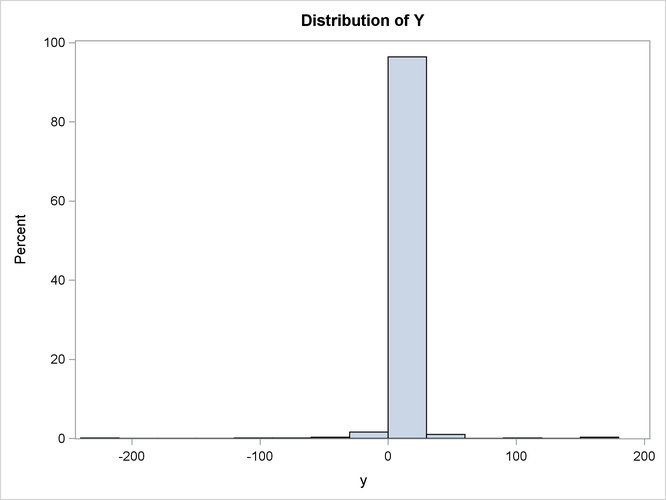The MODEL Procedure
Example 26.12 Cauchy Distribution Estimation
In this example a nonlinear model is estimated by using the Cauchy distribution. Then a simulation is done for one observation in the data.
The following DATA step creates the data for the model.
/* Generate a Cauchy distributed Y */
data c;
format date monyy.;
call streaminit(156789);
do t=0 to 20 by 0.1;
date=intnx('month','01jun90'd,(t*10)-1);
x=rand('normal');
e=rand('cauchy') + 10 ;
y=exp(4*x)+e;
output;
end;
run;
The model to be estimated is

That is, the residuals of the model are distributed as a Cauchy distribution with noncentrality parameter  .
.
The log likelihood for the Cauchy distribution is
![\[ \textrm{ll} = -\log \pi (1+(x-nc)^2) \]](images/etsug_model0670.png)
The following SAS statements specify the model and the log-likelihood function.
title1 'Cauchy Distribution';
proc model data=c ;
dependent y;
parm a -2 nc 4;
y=exp(-a*x);
/* Likelihood function for the residuals */
obj = log(constant('pi')*(1+(-resid.y-nc)**2));
errormodel y ~ general(obj) cdf=cauchy(nc);
fit y / outsn=s1 method=marquardt;
solve y / sdata=s1 data=c(obs=1) random=1000
seed=256789 out=out1;
run;
title 'Distribution of Y';
proc sgplot data=out1;
histogram y;
run;
The FIT statement uses the OUTSN= option to output the  matrix for residuals from the normal distribution. The
matrix for residuals from the normal distribution. The  matrix is
matrix is  and has value 1.0 because it is a correlation matrix. The OUTS= matrix is the scalar 2989.0. Because the distribution is
univariate (no covariances), the OUTS= option would produce the same simulation results. The simulation is performed by using
the SOLVE statement.
and has value 1.0 because it is a correlation matrix. The OUTS= matrix is the scalar 2989.0. Because the distribution is
univariate (no covariances), the OUTS= option would produce the same simulation results. The simulation is performed by using
the SOLVE statement.
The distribution of y is shown in the following output.
Output 26.12.1: Distribution of Y
